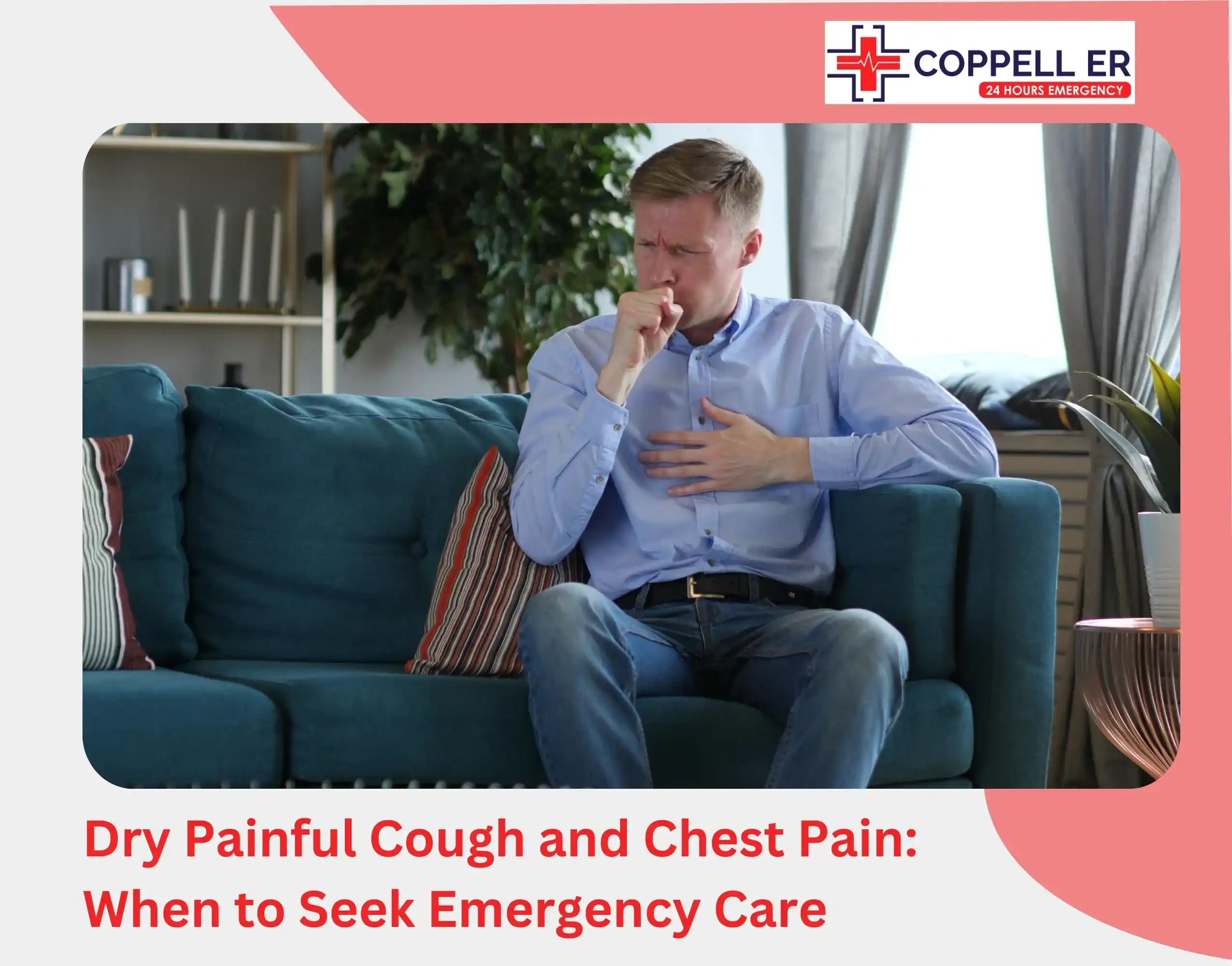Who wants to run to the ER over a little cough? It could be a cold or seasonal allergy that’ll go on its own. But if it’s a dry painful cough and chest pain, that’s when things get concerning.
Coughing clears the throat, but a dry cough accompanied bychest pain indicates that something is beyond cold. It could be acid reflux, asthma acting up, or even a heart attack.
Know the causes of dry painful cough and chest pain, and when you should seek emergency care. It’ll help you catch issues before they get worse. If an infection is the cause, early knowledge helps prevent passing it to family members. So, let’s save yourself and everyone around you.
12 Causes of Dry Painful Cough and Chest Pain

Dry painful cough and chest pain can have multiple causes. Some are mild and go away on their own, while others need serious attention. The most common are:
1. Viral Infections (Colds or Flu)
Viruses attack the lining of your respiratory tract. Your throat, trachea, and lungs become inflamed and a persistent dry cough starts. Continuous coughing strains your chest muscles and causes pain.
When to Seek Emergency Care for Viral Infections:
- Your fever is persistently high (above 103°F) or comes with confusion
- You feel chest tightness or pain that worsens with breathing
2. Asthma
Asthma inflames the airways and worsens with allergens (dust, pollen, or cold air). Your body tries to clear the airways in the form of a dry cough. The muscles around your airways also tighten during an asthma attack which causes chest pain.
Chronic dry cough is prevalent with cough-variant asthma. So, if you have a dry painful cough and chest pain, it could be asthma.
When to Seek Emergency Care for Asthma:
- If you can’t catch your breath and your chest feels extremely tight
- Your rescue inhaler doesn’t help
- If your lips or nails turn blue
3. Acid Reflux (GERD)
If dry cough chest pain happens after eating or worsens at night, GERD can be the culprit. Acid reflux (GERD) causes the stomach acid to flow back into the esophagus, irritating the throat and airways. A dry and persistent cough helps clear the irritation. Acid can cause burning chest pain (heartburn) that worsens with coughing.
When to Seek Emergency Care for Acid Reflux:
- Shortness of Breath After Eating
- Feel like food is stuck in your throat
- You are vomiting blood or have black, tarry stools
4. Pneumonia
Pneumonia is a serious lung infection that can cause a dry painful cough and chest pain due to inflammation. Symptoms include coughing, fever, chills, and chest discomfort.
When to Seek Emergency Care for Pneumonia:
- If you have a fever over 103°F, chills, or extreme fatigue
- If your breathing becomes rapid or labored
- Chest pain worsens with deep breaths
- You cough up thick mucus with a bad odor
5. Pulmonary Embolism
A pulmonary embolism (PE) causes dry painful cough and chest pain when a blood clot blocks an artery in the lungs. The clot reduces oxygen supply, causing sharp chest pain, especially when breathing deeply or coughing.
When to Seek Emergency Care for Pulmonary Embolism:
- You experience shortness of breath or sudden chest pain
- Headache and dizziness
- Your heart rate is irregular without explanation
- You cough up blood
6. Heart Problems
Sometimes, a dry cough chest hurts isn’t about your lungs. It can be a sign of heart attack or pericarditis (inflammation around the heart).
When to Seek Emergency Care for Heart Problems:
- If chest pain is crushing and radiates to your arm, jaw, or back
- You feel lightheaded, nauseous, or sweaty
- You have a history of heart disease
- Sudden, unexplained coughing with chest pain
7. Pneumothorax – Collapsed lung
The air leaks into the space between the lung and chest in pneumothorax (collapsed lung). The leaked air prevents the lung from fully expanding and causes sharp chest pain. The sudden change in lung pressure triggers a dry cough as the body reacts.
When to Seek Emergency Care for Pneumothorax:
- A pneumothorax is a medical emergency. If you have sudden chest pain and trouble breathing, get medical help immediately.
8. Lung Cancer
Though rare, a tumor in the lungs can irritate airways in later stages and cause dry cough. The tumor presses on nerves or tissues, causing chest pain that may worsen with deep breathing or coughing.
When to Seek Emergency Care for Lung Cancer:
- You have a chronic dry painful cough and chest pain that lasts for weeks
- Unexplained weight loss
- You may cough with phlegm, sometimes with blood-streaked mucus
9. Environmental Irritants
Things like smoke, pollution, or cold air can dry out your throat and trigger coughing with some chest discomfort.
When to Seek Emergency Care for Environmental Irritants:
- You inhale toxic fumes or smoke and develop severe breathing issues
- Your throat swells or tightens
- Your chest pain and cough persist even after leaving the area
10. Laryngitis
Laryngitis happens when your vocal cords get inflamed, often from overuse or infection. It can lead to a dry, persistent cough that strains your chest muscles.
When to Seek Emergency Care for Laryngitis:
- Your voice is hoarse that lasts more than two weeks
- You have trouble breathing or swallowing
11. Medication Side Effects
Certain medications, especially ACE inhibitors used for high blood pressure, can cause a dry cough as a side effect.
When to Seek Emergency Care for Medication Side Effects:
- If you’re on medication and notice chest pain from coughing too much, it’s worth bringing it up with your doctor.
12. Smoking
Smoking irritates your throat and lungs, often causing a dry, hacking cough. Over time, repeated coughing can lead to chest pain or even more serious issues like chronic bronchitis or lung damage.
When to Seek Emergency Care for Smoking:
- Your cough is chronic and worsening over time
- You start coughing up blood
- You have frequent respiratory infection
- Chest pain that doesn’t go away
Understanding Phlegm Colors and When to Worry

A dry painful cough and chest pain might evolve into something more visible as your illness progresses. Phlegm production and its changing colors tell an important story about what’s happening in your respiratory system. Let’s look at what these changes mean and when they suggest your condition needs medical attention.
Coughing with Phlegm
A dry cough that suddenly produces phlegm signals your body’s active fight against infection. This change happens when your immune system ramps up mucus production to trap and remove invaders from your airways. Many viral infections naturally progress from dry to wet coughing as part of the healing process.
For most healthy adults, clear or white phlegm typically indicates the early stages of a cold, allergies, or minor irritation. While uncomfortable, this rarely requires emergency attention unless accompanied by severe breathing problems.
Cough with Yellow Mucus: Warning Signs
Yellow mucus signals your immune system’s battle against infection. The yellowish color comes from dead white blood cells that fought bacteria in your respiratory tract. A cough with yellow mucus typically points to bacterial bronchitis or sinusitis.
This color change warrants attention, especially when paired with fever, chest pain, or breathing difficulty. The infection has likely moved deeper into your bronchial tubes or lungs. Yellow phlegm that persists beyond a week suggests your body needs help fighting the infection.
Coughing Green Phlegm: When Infection Takes Hold
Green phlegm contains high concentrations of an enzyme called myeloperoxidase from white blood cells. Coughing green phlegm usually indicates a more established bacterial infection requiring medical intervention.
Don’t ignore green phlegm, especially when accompanied by:
- Fever lasting more than three days
- Sharp chest pain that worsens with breathing
- Shortness of breath or wheezing
- Symptoms that worsen instead of improve after a week
For children, elderly people, and those with weakened immune systems, green phlegm warrants immediate medical attention. At Coppell ER, we can determine whether antibiotics or other treatments are needed to prevent serious complications.
Emergency Care for Dry Cough with Chest Pain

If you experience any of these symptoms, head to the emergency room to start treatment fast. Remember early treatment of dry painful cough and chest pain has higher chances of recovery.
Open 24 hours, seven days a week, Coppell ER treats the underlying condition causing your cough and provides fast relief. It’s better to get help than to keep suffering.
FAQs
1. When can you handle a dry cough at home?
If the cough is mild and getting better; you can eat, drink, and breathe just fine; and your chest pain isn’t getting worse when you move or breathe, you’re probably okay to rest at home. Try home remedies and keep an eye on symptoms. If things get worse, get checked out.
2. Can a dry cough turn into a phlegm cough?
Yes. Though viral infections often start with a dry cough, if the infection gets worse it leads to coughing with phlegm. This switch happens because the body produces mucus to clear out the infection.
3. What does the color of phlegm mean?
White phlegm indicates acid reflux or chronic conditions like COPD. A cough with yellow mucus means your body is fighting an infection like bronchitis, pneumonia, or sinusitis. Coughing green phlegm also indicates a respiratory infection. Pink or red phlegm is the sign of blood in the mucus due to irritation or something serious like a pulmonary embolism.
4. How can the ER help for dry painful cough and chest pain?
At Coppell ER, we stabilize your condition first. If you’re having trouble breathing, we’ll get you oxygen right away. Then, we run blood tests, X-rays, or a CT scan to see if it’s an infection or something serious like a blood clot. After the cause is identified, we give you medicines, and antibiotics if you need them.




